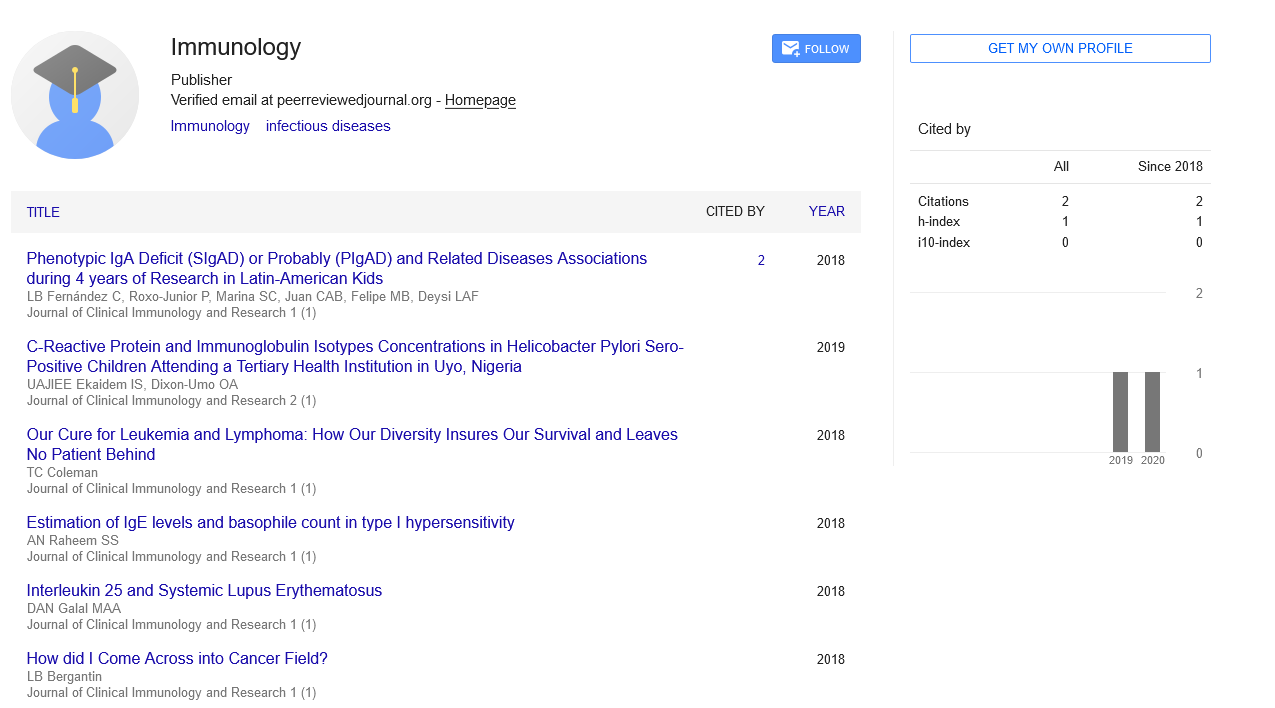Perspective, J Clin Immunol Res Vol: 8 Issue: 1
Neuroimmunology: Bridging the Gap Between the Nervous System and Immune Responses
Adolfo Robles*
Department of Biology and Biochemistry, University of Houston, Houston, United States of America
*Corresponding Author:Adolfo Robles
Department of Biology and Biochemistry, University of Houston, Houston, United States of America
E-mail:Robles2@Central.uh.edu
Received date: 27 December, 2023, Manuscript No. JCIR-23-123701;
Editor assigned date: 29 December, 2023, PreQC No. JCIR-23-123701 (PQ);
Reviewed date: 12 January, 2024, QC No. JCIR-23-123701;
Revised date: 19 February, 2025, Manuscript No. JCIR-23-123701 (R);
Published date: 26 February, 2025, DOI: 10.4172/JCIR.1000098
Citation: Robles A (2025) Neuroimmunology: Bridging the Gap between the Nervous System and Immune Responses. J Clin Immunol Res 8:1.
Abstract
Keywords: Neuroimmunology; Neuroimmune; Central Nervous System (CNS); Molecules
Introduction
Definition of neuroimmunology: Neuroimmunology is the study of interactions between the nervous system and the immune system. This field investigates the bidirectional communication and regulatory mechanisms that shape immune responses within the Central Nervous System (CNS) and peripheral tissues.
Historical perspective: The manuscript provides a historical overview of key milestones in neuroimmunology, from early observations of immune cells within the CNS to the discovery of neuroimmune signaling molecules.
Description
Cellular components of neuroimmunology
Microglia: Microglia, the resident immune cells of the CNS, play a pivotal role in neuroimmunology. The manuscript explores their functions, including surveillance, phagocytosis, and modulation of immune responses.
Astrocytes: Astrocytes, traditionally viewed as support cells, actively participate in neuroimmune interactions. The review discusses their role in immune regulation, neuroprotection, and response to inflammation.
Immune cells in the CNS: The manuscript delves into the presence and functions of immune cells, including T cells and macrophages, within the CNS under both normal and pathological conditions.
Signaling molecules in neuroimmunology
Cytokines and chemokines: Cytokines and chemokines serve as messengers in neuroimmunology, mediating communication between immune and neural cells. The manuscript explores their role in neuroinflammation, neuroprotection, and synaptic plasticity.
Neurotransmitters: Neurotransmitters, traditionally associated with neural signaling, also influence immune responses. The manuscript discusses the impact of neurotransmitters, such as acetylcholine and noradrenaline, on immune cell function.
Neuropeptides: Neuropeptides play a modulatory role in neuroimmune interactions. The manuscript reviews the influence of neuropeptides, including substance P and neuropeptide Y, on immune responses and inflammation.
Neuroimmune interactions in health
Immune surveillance in the CNS: The manuscript discusses the mechanisms by which the immune system surveils the CNS, ensuring protection against infections and maintaining tissue homeostasis.
Neuroimmune regulation of behavior: Neuroimmune interactions play a role in regulating behavior, mood, and cognitive functions. The review explores the impact of immune signaling on neural circuits and mental health.
Neuroimmunology in neurological disorders
Multiple sclerosis: Multiple sclerosis is a prototypical neuroimmune disorder characterized by immune-mediated demyelination. The manuscript examines the pathogenesis and therapeutic implications of neuroimmunology in multiple sclerosis.
Alzheimer's disease: Neuroinflammation is a hallmark of Alzheimer's disease. The manuscript reviews the involvement of neuroimmune processes in disease progression and potential therapeutic strategies.
Parkinson's disease: The interplay between neuroinflammation and neurodegeneration in Parkinson's disease is explored. The manuscript discusses the role of immune responses in the pathogenesis and progression of the disease.
Neuroimmune interactions in immune-mediated disorders
Autoimmune encephalitis: Autoimmune encephalitis involves immune-mediated inflammation of the brain. The manuscript reviews the role of neuroimmune interactions in disease development, diagnosis, and treatment.
Neuromyelitis optica: Neuromyelitis optica, characterized by optic neuritis and myelitis, has strong immunological underpinnings. The review discusses the involvement of neuroimmune processes in disease pathogenesis.
Therapeutic approaches and future directions
Immunomodulation in neurological disorders: The manuscript examines current and emerging immunomodulatory therapies for neurological disorders, emphasizing the potential of targeting neuroimmune interactions.
Precision medicine in neuroimmunology: Advancements in genomics and immunophenotyping enable precision medicine approaches in neuroimmunology. The review discusses the potential for tailoring therapies based on individual patient profiles.
Challenges and opportunities: Challenges in understanding the complexity of neuroimmunology, including the blood-brain barrier and the heterogeneity of neuroimmune responses, are explored. The manuscript also highlights opportunities for future research and therapeutic development.
Conclusion
Neuroimmunology represents a dynamic field that unravels the intricate communication between the nervous and immune systems. As our understanding of neuroimmune interactions deepens, new avenues for therapeutic interventions in neurological and immune-mediated disorders emerge. This manuscript provides a comprehensive overview of the cellular and molecular components of neuroimmunology, their roles in health and disease, and the potential for innovative treatments that bridge the gap between neuroscience and immunology.
 Spanish
Spanish  Chinese
Chinese  Russian
Russian  German
German  French
French  Japanese
Japanese  Portuguese
Portuguese  Hindi
Hindi 